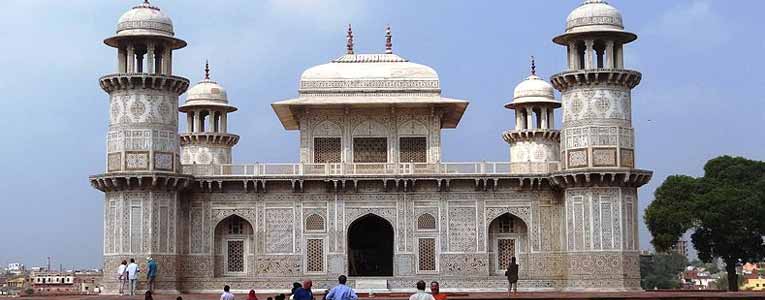


Tomb of I'timād-ud-Daulah is a Mughal mausoleum in the city of Agra in the Indian state of Uttar Pradesh. Often described as a "jewel box", sometimes called the "Baby Tāj", the tomb of I'timād-ud-Daulah is often regarded as a draft of the Tāj Mahal. Along with the main building, the structure consists of numerous outbuildings and gardens. The tomb, built between 1622 and 1628 represents a transition between the first phase of monumental Mughal architecture – primarily built from red sandstone with marble decorations, as in Humayun's Tomb in Delhi and Akbar's tomb in Sikandra – to its second phase, based on white marble and pietra dura inlay, most elegantly realized in the Tāj Mahal.
The tomb itself is one of the best examples of architecture of the region. Said to be one of the most important influences behind the architecture of the Taj Mahal, the Tomb of Itimad Ud Daulah is one of the finest examples of a specific genre of mausoleum architecture called a Tomb in a Garden. The construction is such that the tomb resembles a jewel-box set in the midst of a garden. Tranquil and lush green, the garden where the tomb is constructed is set on the banks of the river Yamuna. Famous for being the first tomb in the entirety of India to be built entirely of white marble, the Tomb of Itimad Ud Daulah is a must see for all visitors visiting the historic city of Agra.
Agra is about 200 km from Delhi (165 if you use the Yamuna Expressway) and is easily accessible by flights, roadways and train services. The travel time from Delhi to Agra by road is around 3 hours. In order to minimize the effects of pollution, vehicles are not allowed in the immediate vicinity of the Taj Mahal. Cars and buses have to park in parking lots a short distance away from the mausoleum complex and tourists can board non-polluting electric buses to reach the Taj Mahal. You can travel from Delhi to Agra, see the Taj Mahal, and return in one day. However, if you wish to see more of the sights of Agra and shop in the city's markets, then it is a good idea to stay overnight.
The best time to visit the Taj Mahal is in the autumn, winter and spring months from October to February. The peak summer months of May to July are best avoided because of the hot weather. The months of October and November, after the monsoon, offer the sight of the Taj at its mesmerising best, as the gardens are lush with greenery and the Yamuna river flows proudly past the Taj Mahal, swollen with post-monsoon rain. Both these factors enhance the overall experience of viewing the Taj Mahal.